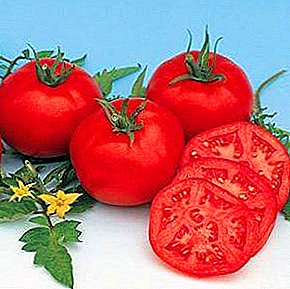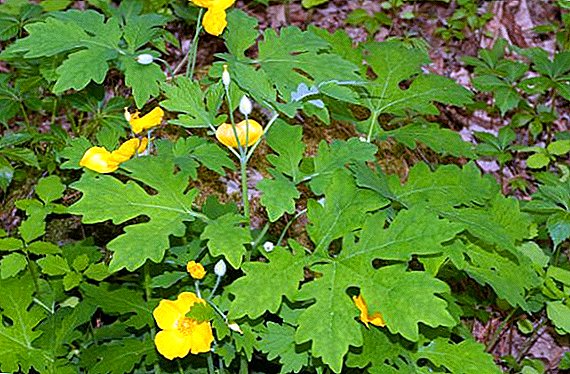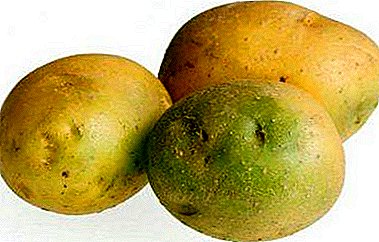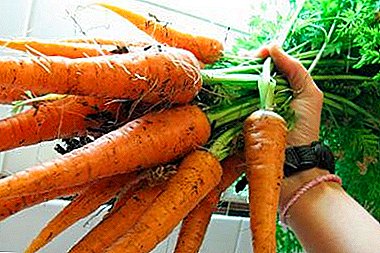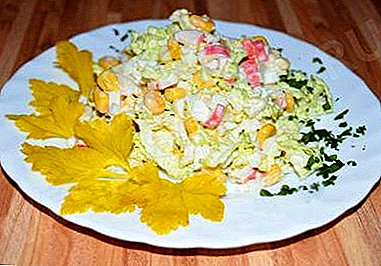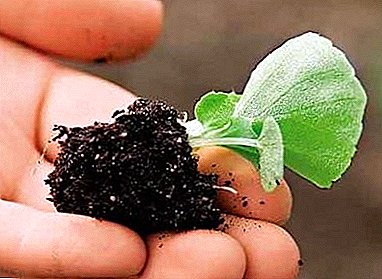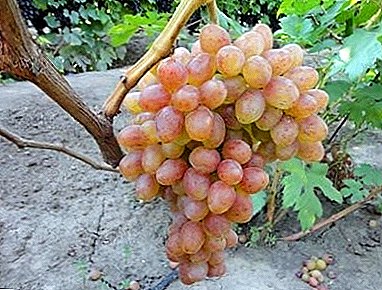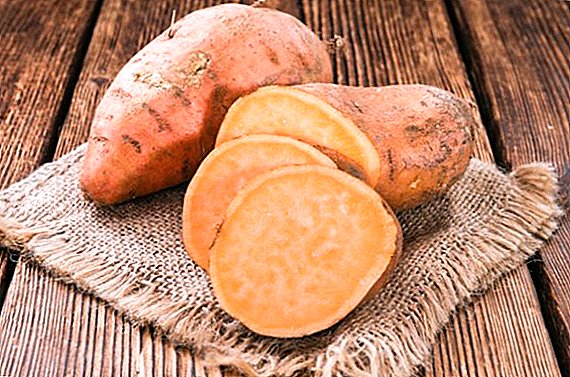 Those who know about the existence of such a vegetable as a sweet potato, usually associate it with warm exotic countries. But it turns out that this vegetable can be grown in a temperate continental climate. This material is devoted to the peculiarities of cultivation of yams in temperate latitudes.
Those who know about the existence of such a vegetable as a sweet potato, usually associate it with warm exotic countries. But it turns out that this vegetable can be grown in a temperate continental climate. This material is devoted to the peculiarities of cultivation of yams in temperate latitudes.
Exotic in the middle lane: what is yam
This tuber-bearing perennial plant belongs to the genus Ilomey and the Vyunkov family. Externally, it is a creeping creeper, whose length can reach five meters. Leaves are heart-shaped or palmate-lobed, flowers are large, white or white-purple. The fruit is a box containing seeds.
Did you know? Of the sweet potato seed is made a drink, somewhat reminiscent of coffee. The leaves, after soaking in water, are added to the salad.
The main value of the sweet potato is its tubers, reaching 30 cm in length. Outwardly, they look like potatoes, but they have no eyes. The flesh is white, yellow, orange, cream - it depends on the variety.  The taste of these tubers is also varied, they can be very sweet, and slightly sweetish, with a nut or chestnut flavor. They are eaten in boiled, fried, baked and cheese types. It is believed that the homeland of the sweet potato is South America, from where it has spread all over the world.
The taste of these tubers is also varied, they can be very sweet, and slightly sweetish, with a nut or chestnut flavor. They are eaten in boiled, fried, baked and cheese types. It is believed that the homeland of the sweet potato is South America, from where it has spread all over the world.
We advise you to learn more about the beneficial properties of such root vegetables as green radish, yellow carrots, cassava, rutabaga, turnips, beets, celery root, daikon, girasol, black and white radish.
In warm countries like China and African countries, it is grown in tens of millions of tons. However, this vegetable can be successfully grown in temperate latitudes, although in a more severe climate it is cultivated as an annual plant, and the size of tubers is smaller than in the tropics.
What varieties are suitable for growing in the middle lane
In the Russian State Register of Breeding Achievements, not a single variety of sweet potatoes is listed. For cultivation, mainly used varieties imported from abroad.
Here are some of them:
- Garnet - medium-early variety, bred in the United States. Tubers are oblong, the flesh is sweet, orange.
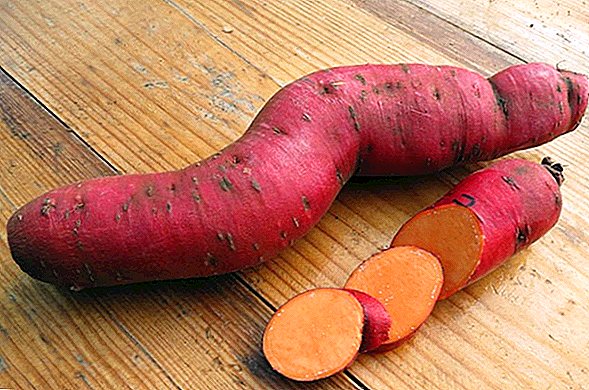
- Tynung T-65 (Tainung T-65) - early Taiwan variety, it has large tubers with yellowish pulp, sweet taste.

- "Purple" (Purple) - a variety from the USA of an average ripening period, the flesh is purple, it tastes like potatoes.
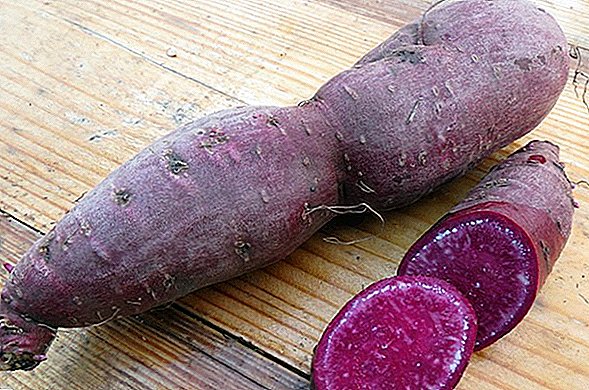
- "Ginseng Red" (Ginseng Red) - a high-yielding variety popular in the world, the flesh is yellowish, sweetish in taste.
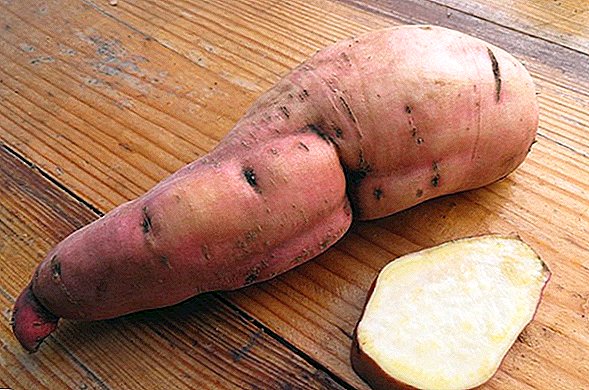
Check out the useful properties of yam
- Victory-100 - bred on the basis of the famous American variety Nancy Hall (Nancy Hall) and is now considered the most common in Russia. The flesh is yellowish, the taste is sweetish.
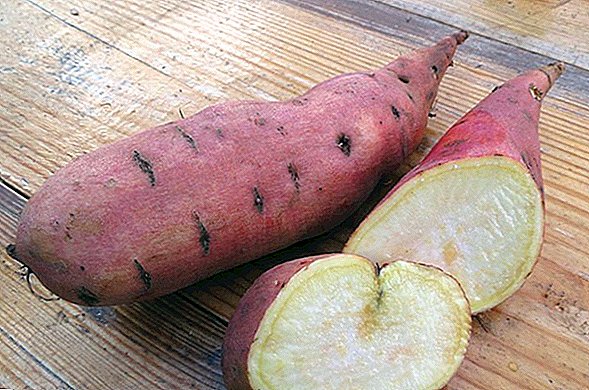
Important! For conditions of a temperate climate, early and mid-season varieties with a growing season of no more than 110 days are most suitable. Planting material is best ordered from local batatovodov or in European specialty stores.
Peculiarities of sweet potato germination: how to grow seedlings
The sweet potato is propagated by cuttings - these are sprouts germinated on the tuber. From one tuber, depending on the variety, you can get from 10 to 50 cuttings. For the germination of vegetables prepare the substrate: mix equal parts of light soil, humus and sand.
They begin to germinate in February or in March, it depends on the local microclimate. Tubers must be healthy, without mechanical damage and soft areas.  There are several ways of germination, more about them described below.
There are several ways of germination, more about them described below.
Germination in water
In this method, the tuber is placed in a glass of water so that the lower part is submerged in water by 1-2 cm. Water is periodically changed. When sprouts appear, the tuber is transplanted into a container with the substrate; otherwise, there is a danger of rotting. Usually tubers are kept in water for no more than a month.
Important! If you buy yam for planting in regular stores, it can be processed with inhibitors, i.e. substances that prevent the emergence of sprouts on the tuber. In this case, germinate the tubers is unlikely to succeed.

Sprouting in the soil
The most common practice of sprouting yams in the soil. The substrate is prepared in the manner described above. Horizontal or vertical planting of tubers is used, both methods have no particular advantages over each other.
We recommend that you get acquainted with the nuances of growing such root vegetables as parsnips, beets, scorzonera, Jerusalem artichokes, turnips, celery, turnips and black radish.
Horizontal
In this case, the tuber is laid on the substrate horizontally, on its side, and slightly dripped. It is recommended that the substrate be regularly moistened; it is recommended to keep the container with the tuber which has sprouted in a well-lit place at room temperature not lower than + 20C. 
Vertical
The easiest way - half of the tuber is buried in the ground and regularly watered at room temperature, keeping the soil constantly moist. After the sprouts appear, it is necessary to provide them with good illumination.
In another method of sprouting, the tuber is cut across into two halves, buried in a slice down into the substrate and watered. With this method, cuttings appear earlier and in large quantities, but the danger of rotting of the tuber increases. 
When to transplant seedlings
The cuttings can be transplanted into the open ground, when their dimensions reach 15-20 cm. If the shoots have reached the desired size, and they cannot be planted in the open ground, the seedlings are left indoors. When the weather allows to transplant seedlings, cuttings of the required length are cut off.
As for climatic conditions, usually transplantation takes place in May or in early June, when there is no danger of return frost. Cuttings need to prepare for planting.
They are carefully separated from the tuber (better cut), but if the lower leaves are formed, they are removed. Next, the cuttings are placed in water for several days. During this time, the root system should begin to form. After the appearance of the roots, cuttings can be planted in open ground.
Planting sweet potatoes in open ground
After proper preparation of the cuttings and the establishment of consistently warm weather, the sweet potato is planted in open ground, which should warm up to + 15 ° C ... + 18 ° C. 
Site selection
Light fertile soils are most favorable for this vegetable, but it can grow on almost any. The site where he lands, should be well lit and sheltered from the wind. The plant does not like shade and stagnant water due to poor drainage.
It is better to form high bulk beds, then it will be easier to dig out the crop. To keep warm, you can (and often just need to) cover the bed with plastic wrap with holes for the yam shoots, in this case, sprinkled the holes with sand. The site of this crop can be pumpkin, onion and tomato.
Landing pattern
The best result is obtained by slanting planting cuttings, while in the ground should be at least two nodes, from which the roots sprouted. However, some gardeners simply stick cuttings without roots into the ground and then water them abundantly - this method saves a lot of time, but often not all cuttings take root.
Video: sweet potato landing
The distance between rows when planting is 70 cm, and the plants themselves in rows are planted at a distance of approximately 30 cm from each other.
How to grow yam in the middle lane: the rules of care
Before planting, it is recommended to apply complex mineral fertilizers to the soil with an obligatory sulfate content. After planting, you can feed the plant with organic matter, no more than two times during the summer - it can be a mullein with the addition of 50 g of superphosphate per bucket at the consumption of a solution bucket per square meter of bed.
In mid-August, the yam is fed with potash fertilizers. A good option for such dressing - ash infusion, when they take 2 cups of ash in a bucket of water and insist a week with periodic stirring.
In the first month after planting, the beds are watered in such a way that the ground is constantly moistened. Then the intensity of irrigation is reduced, regular irrigation is carried out when the top layer of the soil dries out. Two weeks before harvesting, watering is stopped, otherwise the tubers will be too watery.  If the bed is not covered with foil, then there is a danger of the rooting of internodes of the shoots. They are struggling with this by simply lifting the plants and tearing off such roots. If this is not done, the harvest may significantly decrease, in some cases to zero.
If the bed is not covered with foil, then there is a danger of the rooting of internodes of the shoots. They are struggling with this by simply lifting the plants and tearing off such roots. If this is not done, the harvest may significantly decrease, in some cases to zero.
This vegetable is practically not subject to diseases. If the site is poorly drained and the water after watering stagnates, it may be slightly affected by the fungus. Of the pests, mouse voles represent a significant danger.
To combat them, you can use a fence of fine-meshed metal mesh 30 cm high, which is also added dropwise approximately 30 cm deep. They fight with mice and with the help of traps, electronic scarers, poisoned baits (in this case it is better to use the services of specialists).
Harvesting and storage
The term of harvesting depends on the variety of sweet potatoes, usually it is 90-120 days after planting.
Video: sweet potato harvest
An indirect sign that it's time to clean up is a massive yellowing of the foliage of the plant. Carefully dig up the tubers, as they are easily damaged. To ensure long-term storage of the crop, sweet potato tubers are subjected to a treatment procedure.
This procedure consists in the fact that the tubers lay out a warm dry place for a period of 10 days to 2 weeks. The ideal temperature for this is + 30 ° + 35 ° C. Store the crop in boxes or boxes with ventilation at a temperature of + 20 ° C. When storing it is important to move the tubers as little as possible, this can lead to their damage and rotting.
Did you know? The name "sweet potato" is borrowed from the Arawak language - these are Indian tribes living in South and Central America.
Possible mistakes when growing
Often beginners batatovody make typical mistakes when growing this vegetable. 
The most common are the following:
- delay in the germination of tubers, which leads to too late planting of plants in open ground;
- in a fairly cool climate, the bed is not covered with a film, which slows down or even stops the development of the plant;
- planting next to the yam beds of high and branching crops such as corn or soybeans — they are able to obscure and stifle the yam plantings;
- there is no fight with vole mice that multiply rapidly and are able to destroy the entire crop.
Batata, despite the tropical origin, it is possible to grow in the climatic conditions of the middle zone. His cultivation of special difficulties does not cause, but you need to know a number of nuances and meticulously carry out all the necessary agrotechnical techniques.  Good taste of sweet potatoes give sufficient reasons for gardeners to start growing this crop.
Good taste of sweet potatoes give sufficient reasons for gardeners to start growing this crop.








